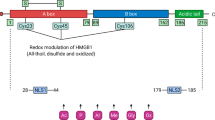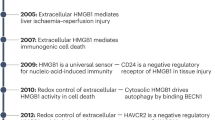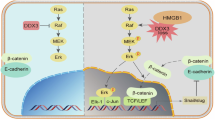Abstract
Antibacterial factors were purified from human adenoid glands by tissue extraction and consecutive steps of reversed-phase chromatography and assayed for bactericidal activity against the airway pathogen Moraxella catarrhalis and also Escherichia coli and Bacillus megaterium. One of the most active components isolated from adenoids was identified by N-terminal sequence analysis and mass spectrometry as high mobility group box chromosomal protein 1 (HMGB1). This novel finding was further substantiated by Western blot analysis, demonstrating a protein of expected size reactive with HMGB1 antiserum. Local synthesis was confirmed by reverse-transcriptase PCR and in situ hybridization. Adenoid-derived HMGB1 and recombinant HMGB1 revealed comparable antibacterial activity at high rate. More than 95% of bacteria were eradicated within 5 min by HMGB1 in the cultures. Secretion from the adenoid gland surface was also demonstrated to contain antibacterial activity, mainly mediated by α-defensins, but not by HMGB1. We conclude that HMGB1, produced and stored intracellularly in the adenoid gland, contributes to the local antibacterial barrier defense system in the upper respiratory tract.
Similar content being viewed by others
Log in or create a free account to read this content
Gain free access to this article, as well as selected content from this journal and more on nature.com
or
Abbreviations
- HMGB1:
-
high mobility group box chromosomal protein 1
- rHMGB1:
-
recombinant HMGB1
References
Boman HG 2000 Innate immunity the normal microflora. Immunol Rev 173: 5–16
Ganz T, Lehrer RI 1999 Antibiotic peptides from higher eukaryotes: biology applications. Mol Med Today 5: 292–297
Synthesis and Bioactivity of Antimicrobial Peptides and Pseudopeptide Inhibitors of HIV Aspartic Protease. Biochimica e Biochimica Applicata per Chimica e Tecnologia Farmaceutiche Web site. Available at: http://www.bbcm.univ.trieste.it/~tossi/. Accessed May 10 2002
Cole AM, Dewan P, Ganz T 1999 Innate antimicrobial activity of nasal secretions. Infect Immun 67: 3267–3275
Mathews M, Jia HP, Guthmiller JM, Losh G, Graham S, Johnson GK, Tack BF, McCray PB 1999 Production of beta-defensin antimicrobial peptides by the oral mucosa salivary glands. Infect Immun 67: 2740–2745
Rynnel-Dagöö B, Lindberg K, Samuleson A, Blomberg S, Forsgren J 1997 The immunology of the host-parasite relationship in the nasopharynx. Ann N Y Acad Sci 830: 32–48
Johns E 1982 The HMG Chromosomal Proteins. Academic Press, London
Bianchi ME 1988 Interaction of a protein from rat liver nuclei with cruciform DNA. EMBO J 7: 843–849
Bianchi ME, Beltrame M, Paonessa G 1989 Specific recognition of cruciform DNA by nuclear protein HMG1. Science 243: 1056–1059
Bianchi ME 1991 Production of functional rat HMG1 protein in Escherichia coli. Gene 104: 271–275
Maher JF, Nathans D 1996 Multivalent DNA-binding properties of the HMG-1 proteins. Proc Natl Acad Sci U S A 93: 6716–6720
Murphy FVT, Sweet RM, Churchill ME 1999 The structure of a chromosomal high mobility group protein-DNA complex reveals sequence-neutral mechanisms important for non-sequence-specific DNA recognition. EMBO J 18: 6610–6618
Brickman JM, Adam M, Ptashne M 1999 Interactions between an HMG-1 protein members of the Rel family. Proc Natl Acad Sci U S A 96: 10679–10683
Rauvala H, Pihlaskari R 1987 Isolation some characteristics of an adhesive factor of brain that enhances neurite outgrowth in central neurons. J Biol Chem 262: 16625–16635
Merenmies J, Pihlaskari R, Laitinen J, Wartiovaara J, Rauvala H 1991 30-kDa heparin-binding protein of brain (amphoterin) involved in neurite outgrowth. Amino acid sequence localization in the filopodia of the advancing plasma membrane. J Biol Chem 266: 16722–16729
Taguchi A, Blood DC, del Toro G, Canet A, Lee DC, Qu W, Tanji N, Lu Y, Lalla E, Fu C, Hofmann MA, Kislinger T, Ingram M, Lu A, Tanaka H, Hori O, Ogawa S, Stern DM, Schmidt AM 2000 Blockade of RAGE-amphoterin signalling suppresses tumour growth metastases. Nature 405: 354–360
Wang H, Bloom O, Zhang M, Vishnubhakat J, Ombrellino M, Che J, Frazier A, Yang H, Ivanova S, Borovikova L, Manogue K, Faist E, Abraham E, Andersson J, Andersson U, Molina P, Abumrad N, Sama A, Tracey K 1999 HMG-1 as a late mediator of endotoxin lethality in mice. Science 285: 248–251
Ombrellino M, Wang H, Ajemian MS, Talhouk A, Scher LA, Friedman SG, Tracey KJ 1999 Increased serum concentrations of high-mobility-group protein 1 in haemorrhagic shock. Lancet 354: 1446–1447
Abraham E, Arcaroli J, Carmody A, Wang H, Tracey KJ 2000 HMG-1 as a mediator of acute lung inflammation. J Immunol 165: 2950–2954
Andersson U, Wang H, Palmblad K, Aveberger AC, Bloom O, Erlandsson-Harris H, Janson A, Kokkola R, Zhang M, Yang H, Tracey KJ 2000 High mobility group 1 protein (HMG-1) stimulates proinflammatory cytokine synthesis in human monocytes. J Exp Med 192: 565–570
Degryse B, Bonaldi T, Scaffidi P, Muller S, Resnati M, Sanvito F, Arrigoni G, Bianchi ME 2001 The high mobility group (HMG) boxes of the nuclear protein HMG1 induce chemotaxis cytoskeleton reorganization in rat smooth muscle cells. J Cell Biol 152: 1197–1206
Moore KS, Bevins CL, Brasseur MM, Tomassini N, Turner K, Eck H, Zasloff M 1991 Antimicrobial peptides in the stomach of Xenopus laevis. J Biol Chem 266: 19851–19857
Hultmark D, Engström A, Andersson K, Steiner H, Bennich H, Boman HG 1983 Insect immunity. Attacins, a family of antibacterial proteins from Hyalophora cecropia. EMBO J 2: 571–576
Pütsep K, Normark S, Boman HG 1999 The origin of cecropins; implications from synthetic peptides derived from ribosomal protein L1. FEBS Lett 451: 249–252
Dagerlind A, Friberg K, Bean AJ, Hökfelt T 1992 Sensitive mRNA detection using unfixed tissue: combined radioactive non-radioactive in situ hybridization histochemistry. Histochemistry 98: 39–49
Wen L, Huang JK, Johnson BH, Reeck GR 1989 A human placental cDNA clone that encodes nonhistone chromosomal protein HMG-1. Nucleic Acids Res 17: 1197–1214
Frohm M, Gunne H, Bergman AC, Agerberth B, Bergman T, Boman A, Liden S, Jörnvall H, Boman HG 1996 Biochemical antibacterial analysis of human wound blister fluid. Eur J Biochem 237: 86–92
Lee KB, Brooks DJ, Thomas JO 1998 Selection of a cDNA clone for chicken high-mobility-group 1 (HMG1) protein through its unusually conserved 3′-untranslated region, improved expression of recombinant HMG1 in Escherichia coli. Gene 225: 97–105
Wang H, Vishnubhakat JM, Bloom O, Zhang M, Ombrellino M, Sama A, Tracey KJ 1999 Proinflammatory cytokines (tumor necrosis factor interleukin 1) stimulate release of high mobility group protein-1 by pituicytes. Surgery 126: 389–392
Boman HG, Agerberth B, Boman A 1993 Mechanisms of action on Escherichia coli of cecropin P1 PR-39, two antibacterial peptides from pig intestine. Infect Immun 61: 2978–2984
Pütsep K, Branden CI, Boman HG, Normark S 1999 Antibacterial peptide from H. pylori. Nature 398: 671–672
Hirsch JG 1958 Bactericidal action of histone. J Exp Med 108: 925–944
Park IY, Park CB, Kim MS, Kim SC 1998 Parasin I, an antimicrobial peptide derived from histone H2A in the catfish, Parasilurus asotus. FEBS Lett 437: 258–262
Acknowledgements
The authors thank Associate Professor R.A. Harris for linguistic advice.
Author information
Authors and Affiliations
Corresponding author
Additional information
Supported by grants from the Swedish Medical Research Council (Projects 8282, 11412, 03X-10832, 71X-13496, and 03X-3532), the Knut and Alice Wallenberg Foundation, the Carl Trygger Foundation, the Swedish Cancer Society (projects 2677 and 4159), the Swedish Research Council (project K5104-20005891), the Children Cancer Fund, the Foundation Frimurare Barnhuset in Stockholm, H.R.H. Crown Princess Lovisa Society of Pediatric Health Care, the Society for Child Care, the Swedish Society of Medicine, the Foundation of Lennander, the Samariten Foundation, and the Solstickan Foundation.
Rights and permissions
About this article
Cite this article
Zetterström, C., Bergman, T., Rynnel-Dagöö, B. et al. High Mobility Group Box Chromosomal Protein 1 (HMGB1) Is an Antibacterial Factor Produced by the Human Adenoid. Pediatr Res 52, 148–154 (2002). https://doi.org/10.1203/00006450-200208000-00004
Received:
Accepted:
Issue date:
DOI: https://doi.org/10.1203/00006450-200208000-00004
This article is cited by
-
The HMGB1 protein induces a metabolic type of tumour cell death by blocking aerobic respiration
Nature Communications (2016)
-
High-mobility group box 1 (HMGB1) in childhood: from bench to bedside
European Journal of Pediatrics (2014)
-
Amino acid residues 201-205 in C-terminal acidic tail region plays a crucial role in antibacterial activity of HMGB1
Journal of Biomedical Science (2009)
-
Mechanisms of Disease: the role of high-mobility group protein 1 in the pathogenesis of inflammatory arthritis
Nature Clinical Practice Rheumatology (2007)



